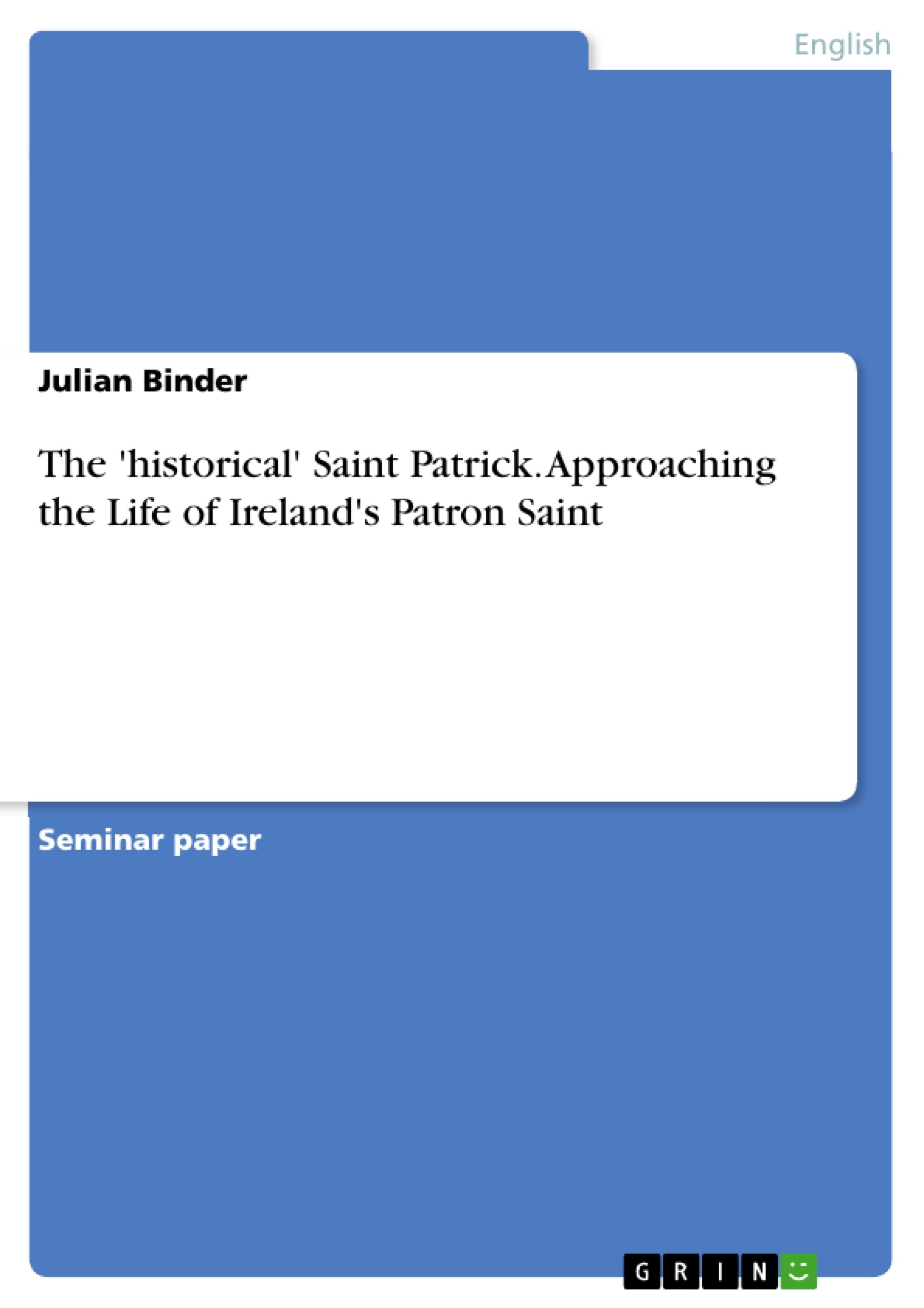When hearing the name 'Saint Patrick', people nowadays think of a bearded, often staffbearing, Irishman who was the first to introduce Christianity to the Emerald Isle, who chased the serpents out of Ireland, and who made use of a shamrock to explain the Holy Trinity. This is the conventional representation of Ireland's National Apostle, and this is what a very high percentage of Saint Patrick's Day visitors would give as an answer if you asked them who Saint Patrick has been. However, this depiction of Ireland´s patron saint is as different from the 'real Patrick' who lived most likely between the end of the fourth and the middle of the fifth century A.D. as is the modern, secular way of celebrating March 17, 'Saint Patrick's Day', with parades, rugby matches, and green beer from its traditional, religious origins, the feast of St. Patrick's 'falling asleep', which had been celebrated as early as the ninth century. Neither was he Irish, nor was he the first to introduce Christianity on the island, nor did he chase any of the poisonous snakes out of Ireland as there simply were none in the country after the most recent Ice Age.
So, in fact, the prevailing popular image of Saint Patrick is – at least historically speaking – distorted and inaccurate. What may be the reason for such a misrepresentation of the 'real Patrick'? Allanah Hopkin gets to the core of the problem by stating that “[m]any people still confuse the Saint Patrick of legend with the very different historical figure.” In her work The Living Legend of Saint Patrick, she points out the different developmental stages of the representations of Patrick over the centuries. According to her, even Patrick's earliest biographers elevated Patrick´s life to that of a secular hero.
In the following lines, a brief overview of the sources on the 'historical Patrick' will be provided. Then, a chronological reconstruction of Patrick's life and mission will be attempted on the basis of the saint's Confession. It is also an aim of this paper to find out what kind of man Patrick was and what role he played in the conversion of Ireland to Christianity.
Inhaltsverzeichnis (Table of Contents)
- Introduction
- Sources
- The Letter to the soldiers of Coroticus
- The Confession
- Other sources
- Patrick's early life
- Patrick's enslavement
- The time between his escape and his consecration
- Patrick's mission
- Death and burial
- Conclusion
- Works cited
Zielsetzung und Themenschwerpunkte (Objectives and Key Themes)
This paper aims to provide a realistic and historically accurate image of Ireland's patron saint, Saint Patrick, by focusing on the available historical sources and disentangling the "historical Patrick" from the legendary figure. The paper will reconstruct his life and mission, drawing primarily from his own accounts, especially his Confession, while also considering other sources and interpretations to fill in gaps in his narrative.
- Distinguishing between the historical and legendary Saint Patrick
- Examining the challenges of reconstructing Patrick's life due to limited historical evidence
- Analyzing Patrick's own writings and their significance as primary sources
- Exploring the influence of various interest groups on the evolving representation of Saint Patrick
- Investigating the role of Patrick in the conversion of Ireland to Christianity
Zusammenfassung der Kapitel (Chapter Summaries)
- Introduction: This chapter establishes the difference between the popular image of Saint Patrick and the "historical Patrick" who lived in the 5th century A.D. It outlines the historical complexities and challenges associated with reconstructing a truthful depiction of Patrick's life, emphasizing the influence of legends and later embellishments. The chapter lays the foundation for the paper's focus on understanding the "historical Patrick" through his own accounts and available historical sources.
- Sources: This chapter delves into the primary sources available for understanding the "historical Patrick," primarily focusing on his own writings, namely the Confession and the Letter to the soldiers of Coroticus. These two letters, the earliest surviving documents from Ireland, provide valuable insights into Patrick's life and the historical context of 5th century Ireland. The chapter also briefly touches upon other sources, highlighting their limitations and the potential for distortion.
- Patrick's Early Life: This chapter explores Patrick's early life, focusing on his upbringing, his family background, and his initial exposure to Christianity. The chapter may also examine any significant events or experiences during this period that may have shaped his later actions and convictions.
- Patrick's Enslavement: This chapter delves into the pivotal event in Patrick's life—his enslavement in Ireland. It examines the circumstances surrounding his capture, the nature of his captivity, and the experiences that likely contributed to his later conversion and dedication to Christianity. The chapter may also explore the influence of these experiences on his perception of the Irish people.
- The Time Between His Escape and His Consecration: This chapter explores the period following Patrick's escape from captivity, focusing on his journey back to his homeland, his studies and preparation for his mission, and the events that led to his consecration as a bishop. The chapter may also examine any significant spiritual or personal transformations that occurred during this period.
Schlüsselwörter (Keywords)
Key themes and concepts explored in this paper include Saint Patrick, historical reconstruction, sources analysis, hagiography, legend, Irish history, early Christianity, conversion, missionary work, Confession, Letter to the soldiers of Coroticus, historical truth, and the "historical Patrick."
- Arbeit zitieren
- M.A. Julian Binder (Autor:in), 2015, The 'historical' Saint Patrick. Approaching the Life of Ireland's Patron Saint, München, GRIN Verlag, https://www.hausarbeiten.de/document/323653


